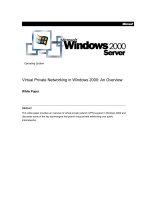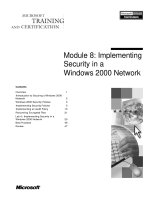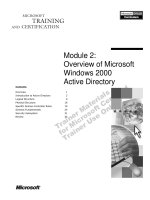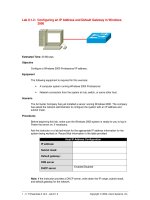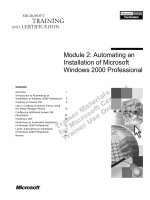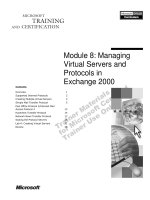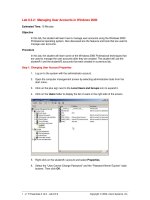Virtual Private Networking in Windows 2000: An Overview
Bạn đang xem bản rút gọn của tài liệu. Xem và tải ngay bản đầy đủ của tài liệu tại đây (234.42 KB, 25 trang )
Operating System
Virtual Private Networking in Windows 2000: An Overview
White Paper
Abstract
This white paper provides an overview of virtual private network (VPN) support in Windows 2000 and
discusses some of the key technologies that permit virtual private networking over public
internetworks.
© 1999 Microsoft Corporation. All rights reserved.
The information contained in this document represents the current view of Microsoft
Corporation on the issues discussed as of the date of publication. Because
Microsoft must respond to changing market conditions, it should not be interpreted
to be a commitment on the part of Microsoft, and Microsoft cannot guarantee the
accuracy of any information presented after the date of publication.
This White Paper is for informational purposes only. MICROSOFT MAKES NO
WARRANTIES, EXPRESS OR IMPLIED, IN THIS DOCUMENT.
The BackOffice logo, Microsoft, Windows, and Windows NT are registered
trademarks of Microsoft Corporation.
Other product or company names mentioned herein may be the trademarks of their
respective owners.
Microsoft Corporation • One Microsoft Way • Redmond, WA 98052-6399 • USA
0499
WHITE PAPER............................................................................ 1
INTRODUCTION......................................................................... 1
Common Uses of VPNs.......................................................................................2
Basic VPN Requirements....................................................................................4
TUNNELING BASICS..................................................................5
Tunneling Protocols.............................................................................................6
Point-to-Point Protocol (PPP)..............................................................................8
Point-to-Point Tunneling Protocol (PPTP)........................................................11
Layer Two Tunneling Protocol (L2TP)..............................................................11
Internet Protocol Security (IPSec) Tunnel Mode.............................................14
Tunnel Types......................................................................................................14
ADVANCED SECURITY FEATURES..........................................16
Symmetric vs. Asymmetric Encryption
(Private Key vs. Public Key)..............................................................................16
Certificates..........................................................................................................17
Extensible Authentication Protocol (EAP)........................................................17
IP Security (IPSec).............................................................................................18
USER ADMINISTRATION ........................................................19
Support in Windows 2000..................................................................................19
Scalability............................................................................................................19
RADIUS...............................................................................................................20
ACCOUNTING, AUDITING, AND ALARMING............................20
CONCLUSION...........................................................................21
FOR MORE INFORMATION.......................................................21
CONTENTS
A virtual private network (VPN) is the extension of a private network that
encompasses links across shared or public networks like the Internet. A VPN
enables you to send data between two computers across a shared or public
internetwork in a manner that emulates the properties of a point-to-point private link.
The act of configuring and creating a virtual private network is known as virtual
private networking.
To emulate a point-to-point link, data is encapsulated, or wrapped, with a header
that provides routing information allowing it to traverse the shared or public transit
internetwork to reach its endpoint. To emulate a private link, the data being sent is
encrypted for confidentiality. Packets that are intercepted on the shared or public
network are indecipherable without the encryption keys. The portion of the
connection in which the private data is encapsulated is known as the tunnel. The
portion of the connection in which the private data is encrypted is known as the
virtual private network (VPN) connection.
Figure 1: Virtual private network connection
VPN connections allow users working at home or on the road to connect in a secure
fashion to a remote corporate server using the routing infrastructure provided by a
public internetwork (such as the Internet). From the user’s perspective, the VPN
connection is a point-to-point connection between the user’s computer and a
corporate server. The nature of the intermediate internetwork is irrelevant to the
user because it appears as if the data is being sent over a dedicated private link.
VPN technology also allows a corporation to connect to branch offices or to other
companies over a public internetwork (such as the Internet), while maintaining
secure communications. The VPN connection across the Internet logically operates
as a wide area network (WAN) link between the sites.
In both of these cases, the secure connection across the internetwork appears to
the user as a private network communication—despite the fact that this
communication occurs over a public internetwork—hence the name virtual private
network.
VPN technology is designed to address issues surrounding the current business
INTRODUCTION
trend toward increased telecommuting and widely distributed global operations,
where workers must be able to connect to central resources and must be able to
communicate with each other.
To provide employees with the ability to connect to corporate computing resources,
regardless of their location, a corporation must deploy a scalable remote access
solution. Typically, corporations choose either an MIS department solution, where
an internal information systems department is charged with buying, installing, and
maintaining corporate modem pools and a private network infrastructure; or they
choose a value-added network (VAN) solution, where they pay an outsourced
company to buy, install, and maintain modem pools and a telecommunication
infrastructure.
Neither of these solutions provides the necessary scalability, in terms of cost,
flexible administration, and demand for connections. Therefore, it makes sense to
replace the modem pools and private network infrastructure with a less expensive
solution based on Internet technology so that the business can focus on its core
competencies. With an Internet solution, a few Internet connections through Internet
service providers (ISPs) and VPN server computers can serve the remote
networking needs of hundreds or thousands of remote clients and branch offices.
Common Uses of VPNs
The next few subsections describe the more common VPN configurations in more
detail.
Remote Access Over the Internet
VPNs provide remote access to corporate resources over the public Internet, while
maintaining privacy of information. Figure 2 shows a VPN connection used to
connect a remote user to a corporate intranet.
Figure 2: Using a VPN connection to connect a remote client to a private intranet
Rather than making a long distance (or 1-800) call to a corporate or outsourced
network access server (NAS), the user calls a local ISP. Using the connection to the
Microsoft VPN Overview White Paper 2
local ISP, the VPN software creates a virtual private network between the dial-up
user and the corporate VPN server across the Internet.
Connecting Networks Over the Internet
There are two methods for using VPNs to connect local area networks at remote
sites:
• Using dedicated lines to connect a branch office to a corporate LAN. Rather
than using an expensive long-haul dedicated circuit between the branch office
and the corporate hub, both the branch office and the corporate hub routers
can use a local dedicated circuit and local ISP to connect to the Internet. The
VPN software uses the local ISP connections and the Internet to create a virtual
private network between the branch office router and corporate hub router.
• Using a dial-up line to connect a branch office to a corporate LAN. Rather
than having a router at the branch office make a long distance (or 1-800) call to
a corporate or outsourced NAS, the router at the branch office can call the local
ISP. The VPN software uses the connection to the local ISP to create a VPN
between the branch office router and the corporate hub router across the
Internet.
Figure 3: Using a VPN connection to connect two remote sites
In both cases, the facilities that connect the branch office and corporate offices to
the Internet are local. The corporate hub router that acts as a VPN server must be
connected to a local ISP with a dedicated line. This VPN server must be listening 24
hours a day for incoming VPN traffic.
Connecting Computers over an Intranet
In some corporate internetworks, the departmental data is so sensitive that the
department’s LAN is physically disconnected from the rest of the corporate
internetwork. Although this protects the department’s confidential information, it
creates information accessibility problems for those users not physically connected
to the separate LAN.
Microsoft VPN Overview White Paper
3
Figure 4: Using a VPN connection to connect to a secured or hidden network
VPNs allow the department’s LAN to be physically connected to the corporate
internetwork but separated by a VPN server. The VPN server is not acting as a
router between the corporate internetwork and the department LAN. A router would
connect the two networks, allowing everyone access to the sensitive LAN. By using
a VPN, the network administrator can ensure that only those users on the corporate
internetwork who have appropriate credentials (based on a need-to-know policy
within the company) can establish a VPN with the VPN server and gain access to
the protected resources of the department. Additionally, all communication across
the VPN can be encrypted for data confidentiality. Those users who do not have the
proper credentials cannot view the department LAN.
Basic VPN Requirements
Typically, when deploying a remote networking solution, an enterprise needs to
facilitate controlled access to corporate resources and information. The solution
must allow roaming or remote clients to connect to LAN resources, and the solution
must allow remote offices to connect to each other to share resources and
information (router-to-router connections). In addition, the solution must ensure the
privacy and integrity of data as it traverses the Internet. The same concerns apply in
the case of sensitive data traversing a corporate internetwork.
Therefore, a VPN solution should provide at least all of the following:
• User Authentication. The solution must verify the VPN client’s identity and
restrict VPN access to authorized users only. It must also provide audit and
accounting records to show who accessed what information and when.
• Address Management. The solution must assign a VPN client’s address on the
intranet and ensure that private addresses are kept private.
• Data Encryption. Data carried on the public network must be rendered
unreadable to unauthorized clients on the network.
• Key Management. The solution must generate and refresh encryption keys for
the client and the server.
• Multiprotocol Support. The solution must handle common protocols used in the
public network. These include IP, Internetwork Packet Exchange (IPX), and so
Microsoft VPN Overview White Paper 4
on.
An Internet VPN solution based on the Point-to-Point Tunneling Protocol (PPTP) or
Layer Two Tunneling Protocol (L2TP) meets all of these basic requirements and
takes advantage of the broad availability of the Internet. Other solutions, including
Internet Protocol Security (IPSec), meet only some of these requirements, but
remain useful for specific situations.
The remainder of this paper discusses VPN concepts, protocols, and components in
greater detail.
Tunneling is a method of using an internetwork infrastructure to transfer data for
one network over another network. The data to be transferred (or payload) can be
the frames (or packets) of another protocol. Instead of sending a frame as it is
produced by the originating node, the tunneling protocol encapsulates the frame in
an additional header. The additional header provides routing information so that the
encapsulated payload can traverse the intermediate internetwork.
The encapsulated packets are then routed between tunnel endpoints over the
internetwork. The logical path through which the encapsulated packets travel
through the internetwork is called a tunnel. Once the encapsulated frames reach
their destination on the internetwork, the frame is decapsulated and forwarded to its
final destination. Tunneling includes this entire process (encapsulation,
transmission, and decapsulation of packets).
Figure 5: Tunneling
The transit internetwork can be any internetwork—the Internet is a public
internetwork and is the most widely known real world example. There are many
examples of tunnels that are carried over corporate internetworks. And while the
Internet provides one of the most pervasive and cost-effective internetworks,
references to the Internet in this paper can be replaced by any other public or
private internetwork that acts as a transit internetwork.
Tunneling technologies have been in existence for some time. Some examples of
mature technologies include:
• SNA tunneling over IP internetworks. When System Network Architecture
Microsoft VPN Overview White Paper
5
TUNNELING BASICS
(SNA) traffic is sent across a corporate IP internetwork, the SNA frame is
encapsulated in a UDP and IP header.
• IPX tunneling for Novell NetWare over IP internetworks. When an IPX packet
is sent to a NetWare server or IPX router, the server or the router wraps the
IPX packet in a UDP and IP header, and then sends it across an IP
internetwork. The destination IP-to-IPX router removes the UDP and IP header
and forwards the packet to the IPX destination.
New tunneling technologies have been introduced in recent years. These newer
technologies—which are the primary focus of this paper—include:
• Point-to-Point Tunneling Protocol (PPTP). PPTP allows IP, IPX, or NetBEUI
traffic to be encrypted, and then encapsulated in an IP header to be sent across
a corporate IP internetwork or a public IP internetwork such as the Internet.
• Layer Two Tunneling Protocol (L2TP). L2TP allows IP, IPX, or NetBEUI traffic
to be encrypted, and then sent over any medium that supports point-to-point
datagram delivery, such as IP, X.25, Frame Relay, or ATM.
• IPSec tunnel mode. IPSec tunnel mode allows IP packets to be encrypted, and
then encapsulated in an IP header to be sent across a corporate IP
internetwork or a public IP internetwork such as the Internet.
Tunneling Protocols
For a tunnel to be established, both the tunnel client and the tunnel server must be
using the same tunneling protocol.
Tunneling technology can be based on either a Layer 2 or a Layer 3 tunneling
protocol. These layers correspond to the Open Systems Interconnection (OSI)
Reference Model. Layer 2 protocols correspond to the data-link layer and use
frames as their unit of exchange. PPTP and L2TP are Layer 2 tunneling protocols;
both encapsulate the payload in a PPP frame to be sent across an internetwork.
Layer 3 protocols correspond to the Network layer, and use packets. IPSec tunnel
mode is an example of a Layer 3 tunneling protocol and encapsulate IP packets in
an additional IP header before sending them across an IP internetwork.
How Tunneling Works
For Layer 2 tunneling technologies, such as PPTP and L2TP, a tunnel is similar to a
session; both of the tunnel endpoints must agree to the tunnel and must negotiate
configuration variables, such as address assignment or encryption or compression
parameters. In most cases, data transferred across the tunnel is sent using a
datagram-based protocol. A tunnel maintenance protocol is used as the mechanism
to manage the tunnel.
Layer 3 tunneling technologies generally assume that all of the configuration issues
are preconfigured, often by manual processes. For these protocols, there may be
no tunnel maintenance phase. For Layer 2 protocols (PPTP and L2TP), however, a
tunnel must be created, maintained, and then terminated.
Microsoft VPN Overview White Paper 6
